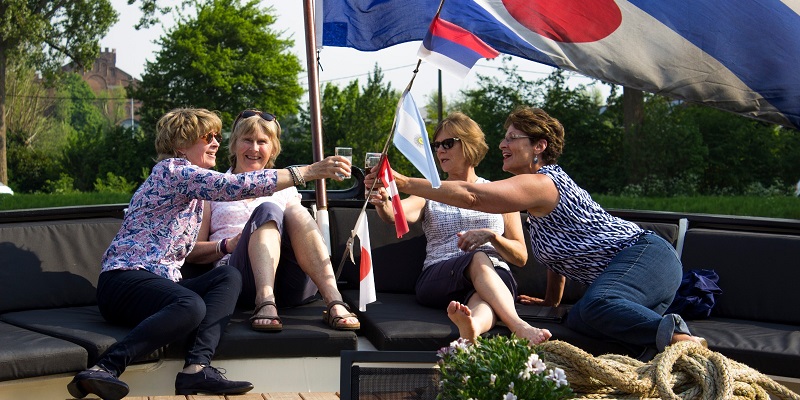With our charter options, you can reserve an entire ship just for your group of 20 or more, providing a unique experience where you and your loved ones have the boat all to yourselves. For groups of at least 12 friends or family members, you can also reserve your own space on select tours, creating a more intimate experience with your closest companions.
Whether it’s a family reunion, a getaway with friends, or a special celebration like a birthday or anniversary, our private charters offer the perfect way to spend quality time together surrounded by beautiful European landscapes.

Customize your charter tour
When you charter an entire boat for your group, you have the freedom to customize your tour in many ways. While the classic format is a cycling cruise with one of our existing tour itineraries, you can also adjust it to suit your group’s needs and interests. Here are a few options:
- Shorten or extend the cycling routes.
- Adjust the itinerary and route to include sights of special interest.
- Create a theme based on a shared group interest, such as music, WWII history, or bird-watching.
- Explore in other ways beyond cycling, such as inline skating, running, or special-interest cycling clubs.
Looking for ideas? Read about how other groups created exciting cultural explorations, fun-filled reunions, and themed adventures together.

Premium service tailored to your group
Coordinating logistics for a group trip can be a challenge. From meal planning to organizing daily activities, these tasks can consume valuable vacation time. At Boat Bike Tours, our expert office team handles all planning and logistics for you. While you relax, our tour leader, chef, and crew onboard ensure you feel like royalty: your cabin is kept tidy, the next day’s itinerary is ready, and after a day of exploring, a delicious three-course meal awaits you. This allows you to focus on what truly matters—enjoying time with your loved ones.

There is no better way to explore Europe together
Imagine carefree days cycling through lush valleys, quaint villages, and past ancient monuments, followed by peaceful evenings drifting along serene canals as the sun sets. Our ships are lovingly called “floating hotels” because they combine the comforts of a hotel with the cozy atmosphere of a ship, where a dedicated crew and professional chef ensure you’re well looked after throughout your journey.
For an authentic experience of European cuisine, culture, art, and architecture with those closest to you, explore our tours and book a holiday you’ll remember for a lifetime.

Convenient conditions and discounts
In today’s uncertain world, planning ahead can be challenging. Our booking policy is designed to give you peace of mind with adaptable terms, so you can book with confidence. For group bookings of 16 to 40 people, we also offer a 6% discount on the total travel sum.

How to book your group holiday
Simply fill in our online form, and our travel advisors will prepare a customized tour proposal based on your preferences. After receiving the offer, you can discuss or make adjustments by phone or email. Then, once you’re ready, book your group trip and get ready to create unforgettable memories!

Why choose Boat Bike Tours?
- Adventure and Comfort: Enjoy the excitement of cycling through Europe’s stunning countryside paired with the relaxation of sailing on a “floating hotel.”
- Personalized Service: Our ships are spacious yet intimate enough to provide attentive, personalized service. Meals feature fresh, locally sourced ingredients, prepared by our expert chef and crew.
- Flexible Cycling Options: Our small, guided biking groups offer flexible routes, allowing you to tailor your cycling experience to your preferred activity level.



